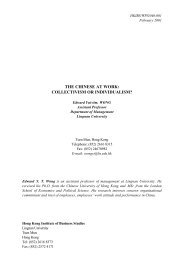West Rail vs. Bus - Lingnan University Library
West Rail vs. Bus - Lingnan University Library
West Rail vs. Bus - Lingnan University Library
Create successful ePaper yourself
Turn your PDF publications into a flip-book with our unique Google optimized e-Paper software.
Proposition 4: White-collar, young, highly educated and high household income<br />
people are more willing to travel <strong>West</strong> <strong>Rail</strong><br />
Crosstabulation is used to determine if there is any relationship between the<br />
willingness of traveling <strong>West</strong> <strong>Rail</strong> and the demographic factor. Table 5.2.5 shows the<br />
comparison of different occupations of the <strong>West</strong> <strong>Rail</strong> and bus passenger. It shows that<br />
occupations do not have a significant impact on the traveling pattern. The Pearson chi<br />
Square test shows the p-value is 0.944. It means that there is no significant<br />
relationship between occupations and traveling pattern.<br />
Table 5.2.5 Crosstabulation of occupation and transportation mode<br />
Occupation Transportation mode Total<br />
<strong>West</strong> <strong>Rail</strong> <strong>Bus</strong> Asymp. Sig. (2-sided)<br />
White collar 38.6% 61.4% 100.0%<br />
Blue collar 37.5% 62.5% 100.0%<br />
Student or housewife 34.8% 65.2% 100.0%<br />
0.944<br />
Total 37.8% 62.2% 100.0%<br />
Table 5.2.6 shows the comparison of the age groups for the <strong>West</strong> <strong>Rail</strong> and<br />
bus passengers. Age does not have a significant impact on the traveling pattern. Table<br />
5.2.7 shows the comparison of the education levels for the <strong>West</strong> <strong>Rail</strong> and bus<br />
passengers. For the Chi-square test, the p-value is 0.304. Thus, we cannot say that it<br />
has a significant relationship.<br />
51









